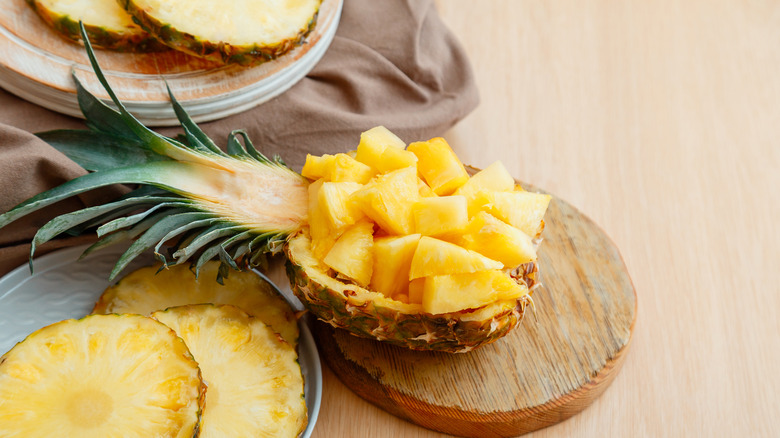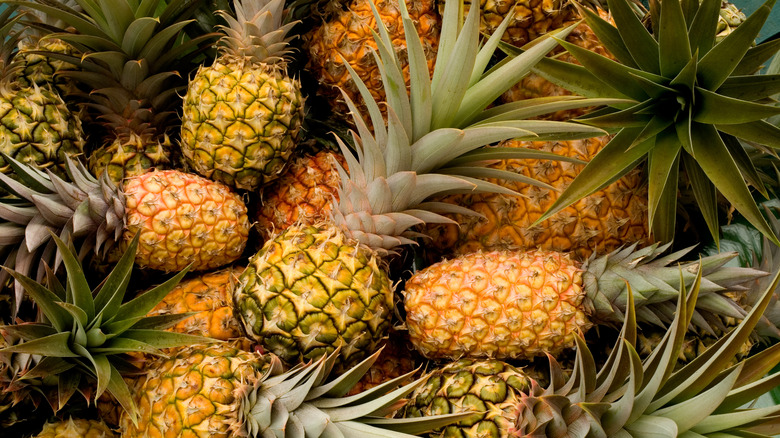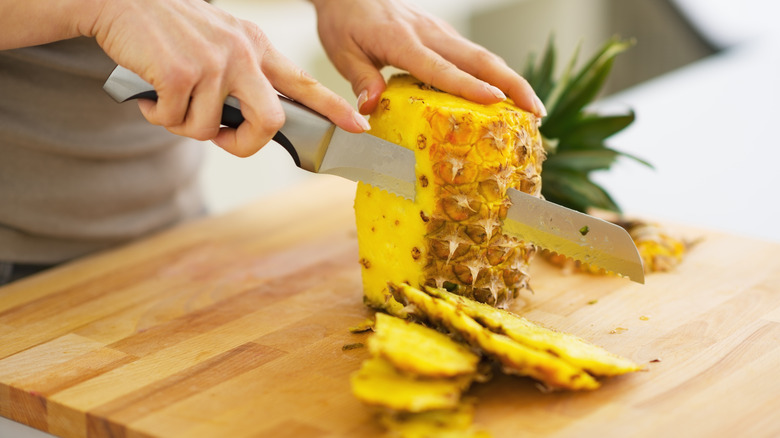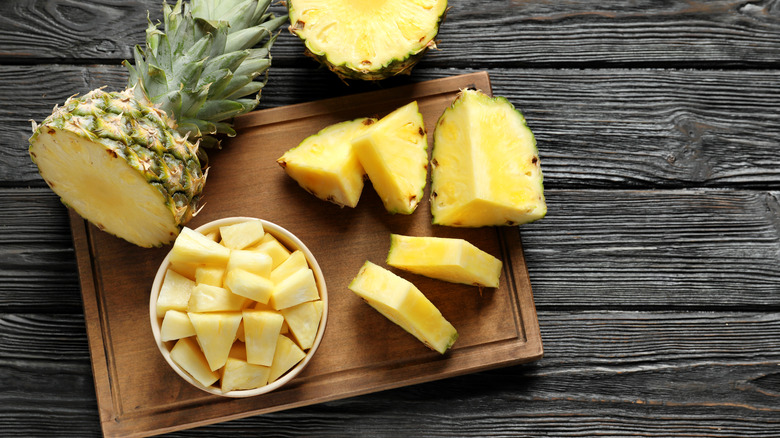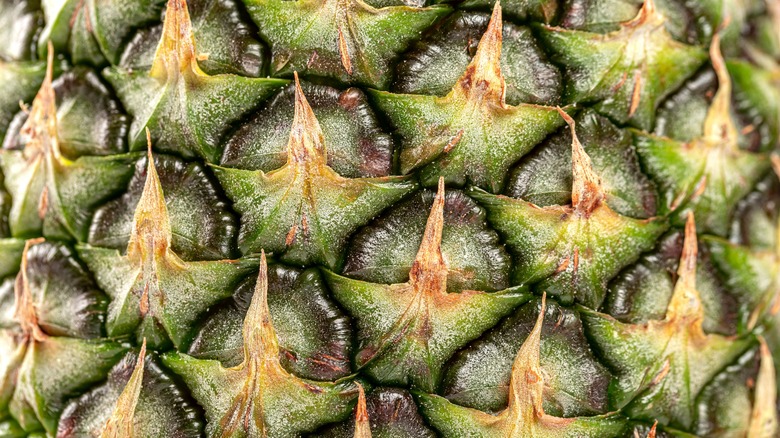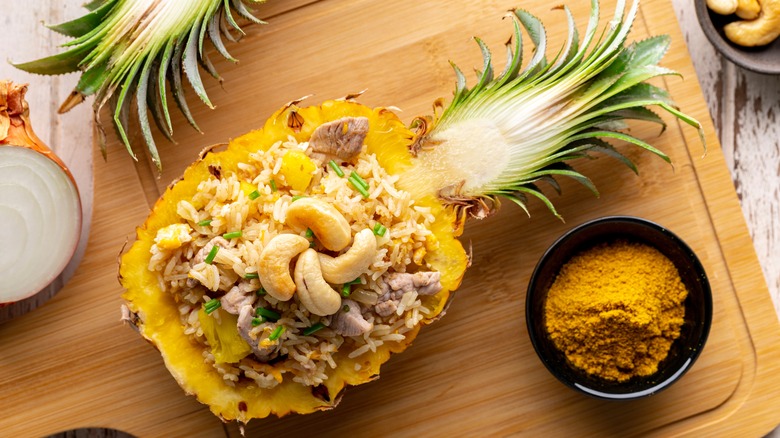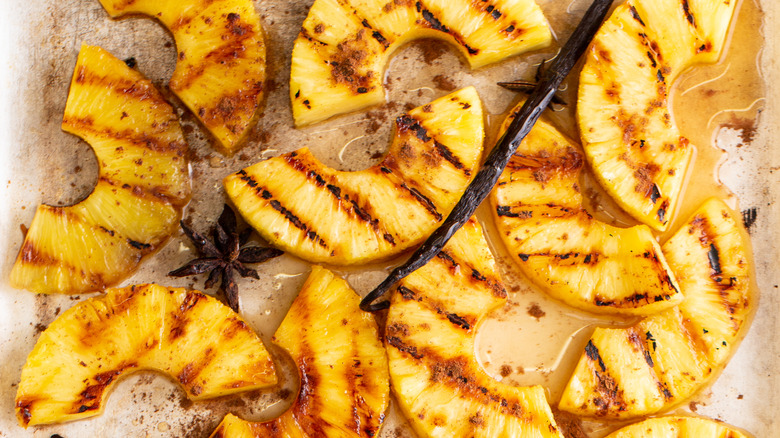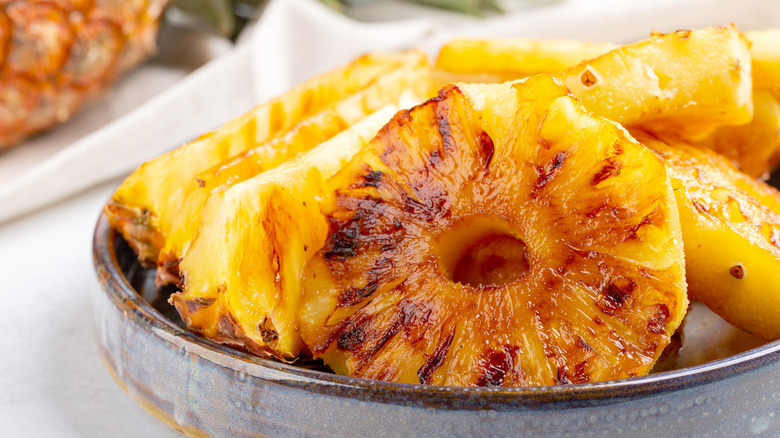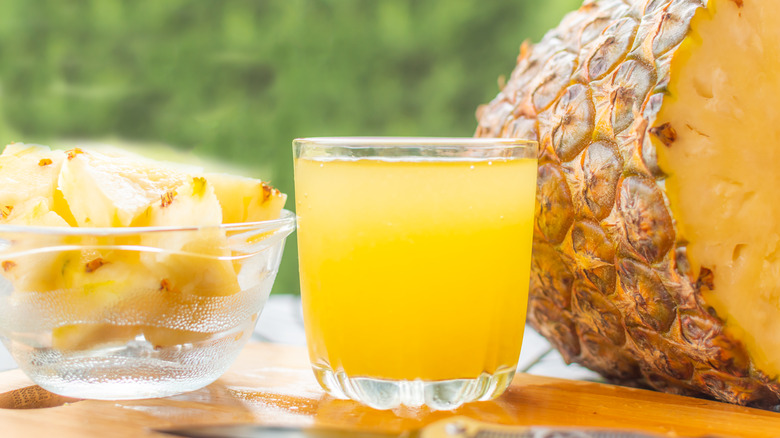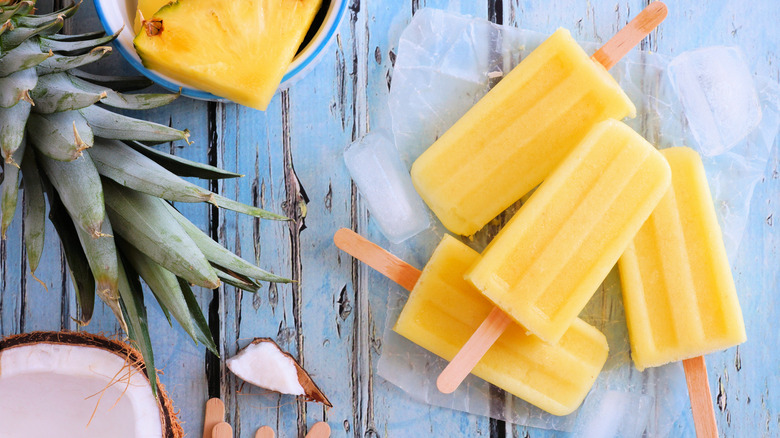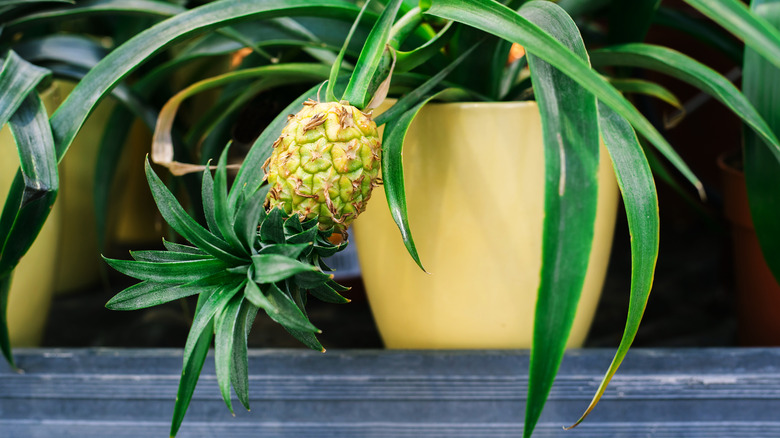14 Tips You Need When Working With Pineapple
Ever notice that the sound of steel drums can transport you to a vacationland filled with sun-soaked palm trees, turquoise oceans, and warm sand between your toes? Besides our sense of sound, smell, and sight, there's another trigger that can teleport you to a tropical destination, and that's taste. Even just one bite of pineapple can set a scene where your to-do list consists of lounging by the pool and a 3:00 p.m. massage. It's juicy, tangy, tart, and sweet all in one finger-licking bite. Pineapple pairs well with dessert, meats, and drinks, and it's available at almost any grocery store. The only major challenge? It's no vacation to work with.
Don't give up. Instead of forgoing your tropical transportation, brush up on some tips your need when working with pineapple. It can be quite a breeze once you get the hang of it, and you may even find that there are plenty of ways to expand your horizons when preparing the spiky fruit.
Pineapples don't ripen once picked
It's essential to choose a perfectly ripe pineapple when perusing the grocery store. This isn't because you won't be able to wait another day until it's ripened, it's because once picked, pineapple barely continues to ripen. Unlike tomatoes, avocados, mangos, and pretty much any other fruit on your countertop, the pineapple you pick is the pineapple you're going to eat, with very little wiggle room.
There are several ways to ensure that you're picking a pineapple that's ready to eat. You shouldn't rely solely on color when picking out pineapple, but it can be a general indicator. A greenish-yellow prickly skin, with fresh green leaves, is a good sign that you're on the right track. This doesn't necessarily mean you should disregard all green pineapple because it's quite possible for a juicy, ripe pineapple to be hiding under all of that tough green skin. Use some of your other senses to test its ripeness. Try picking it up and giving it a light squeeze. It should give just slightly, but not enough to the point where it's mushy. If it's hard and solid, that fruit may never ripen fully.
Use your sense of smell when choosing a pineapple
Don't forget about all of your other senses. You should always smell the bottom of a pineapple when making your selection. Yes, you may feel a bit funny about taking a whiff of the bottom of your fruit in a public grocery store, but it's a good indicator of ripeness and works well for choosing other fruits like cantaloupe as well. So, without shame, lift that spiky fruit in the air, plant your nose on the bottom, and inhale deeply.
You're looking for a sweet, fresh, and boldly fragrant smell. It should be strong and distinctive enough that it's unmistakable. If you're having trouble getting a read on it, it may be unripe. If you're getting a strong smell, but it's vinegary or rotten then this pineapple has seen its day. Remember, since pineapples don't ripen off the tree, avoid getting an underripe fruit in hopes that it will continue to ripen over the next few days on your counter.
Keep pineapples whole for max freshness
Although it can be frustrating that pineapples don't continue to ripen, there are some benefits. The first is that you get what you pay for. Avocados, for instance, can go from solid as a rock to mushy and brown in the blink of an eye. Pineapple isn't so fussy. The other benefit is that they last quite a while before going bad if kept whole. You can store pineapple on the counter for about three days before you'll need to start checking for signs of rotting.
There are several signs to look out for to be sure your pineapple hasn't gone bad. The first is to check those leaves on top. They should be firm and green, and if they begin to brown or fall off then it's likely that the fruit inside is following suit. Another sign is that the bottom of the pineapple is squishy, sticky, or beginning to smell rotten. The skin should be green and yellow, but if it starts to turn golden, orange, or brown then you may be fresh out of luck. If you see any signs of mold, toss it right away.
Removing the tough outer layer of skin is critical
It's so easy to throw a clementine or banana in a purse or backpack and enjoy an easy-to-peel snack on the go. Pineapple, on the other hand, takes a little more love and affection to prepare. Their spiky armadillo-like exterior is certainly something you wouldn't want to chomp into, so it's critical to remove it properly.
Wait to cut into the pineapple after you flip it upside down. Let it rest this way for a few days, if possible, or even just a few hours. This helps the sweet sugar that's concentrated from the base seep into the rest of the fruit. From there, you can remove the skin using a sharp knife and then cut out the core.
As an alternative, forget the utensils and use the TikTok hack for opening a pineapple without a knife. Twist off the top of the pineapple, and then tap the base firmly against a hard surface while turning it. You'll want to do this about 10 times. After that, place the fruit on its side, and roll it while pressing down firmly with your hands to loosen up the inside pulp. From there, you should be able to grab those little spiky tabs on the outside and pull out bite-sized pieces. If you're having trouble getting anything to come out, try the technique again until it loosens.
Cut pineapple should be in an airtight container
Although pineapple doesn't ripen after being picked, that doesn't mean it won't go bad or rot. Once it's been cut, it should be stored properly to ensure that it stays fresh long enough to enjoy every last bite. Unlike apples or bananas, it would be pretty difficult for a single person to consume the whole fruit in one sitting, so it's important to understand the best way to store cut pineapple.
Once the skin has been removed, and it's been sliced and diced, pineapple can be stored in the refrigerator in an airtight container for five to seven days. This means you'll need a tightly sealed Tupperware container or air-tight zip baggie. If you're hoping to keep your fruit around for longer, consider freezing it for up to a year. Frozen pineapple can be defrosted and enjoyed, or take advantage of its frozen state and whip up a batch of frozen piña coladas.
Don't waste pineapple skins or core
Just because pineapple skins look like some sort of prehistoric dinosaur doesn't mean they deserve to be tossed in the trash, composed, or ripped apart by the garbage disposal. But, don't get us wrong; this doesn't mean you should bite right into the prickly, spiny outer layer either. Both the skins and core hold a lot of flavor and natural sugars, and just like your veggie scraps can be used for vegetable broth, pineapple scraps can be used for something much sweeter.
Pineapple skin can be boiled with water, then strained to make pineapple tea, which is similar to juice but with less pulp, and it can be cooked down into a sticky syrup. This syrup can be used in beverages, to sweeten everyday recipes like barbecue sauce or muffins, or it can be drizzled on ice cream. Try making pineapple syrup ice cubes for your fruit juice or iced tea.
The absolute best use for your leftover pineapple core includes shredding it and freezing it into popsicles. This can be done by grating it with a fine cheese grater or using your blender or food processor to get the job done quickly.
Use pineapple to tenderize meat
Ever feast on pineapple and then notice that your tongue and mouth feel funny afterward? Some people report a burning or fuzzy feeling, while others notice itching, irritation, or swelling. Well, this is quite common, and it's not because we are all allergic to the tropical fruit. It's because pineapple is carnivorous. Okay, well that makes it sound more dramatic than it is, but, in reality, pineapple has a component to it that breaks down protein, so we aren't that far off.
However, because of its special abilities, pineapple makes a good meat tenderizer and should be considered in marinades not only for its carnivorous abilities but for its sweet and bold flavor as well. The enzyme called bromelain breaks down collagen fibers, dissolving them in all proteins. But don't worry about pineapple digesting your tongue or mouth, humans have an enzyme in our saliva that neutralizes this interaction.
Pineapple pairs particularly well with pork and sweet sauces like barbecue or teriyaki. It has a strong flavor, so be cautious when enjoying it with fish or other mild meats. Impress guests at your next barbecue grill as you let our favorite tropical fruit tenderize your ribs, pork chop, or chicken breasts.
Spice it up
Just because pineapple has a bold, tangy flavor, doesn't mean it can be enhanced using spices. The beauty of pineapple is that it tastes delicious with both classically sweet and savory spices, so you're not restricted when it comes to loading on the flavor. Start sweet with classics like cinnamon or anise. Add maple syrup, brown sugar, white sugar, or honey for the ultimate sticky-sweet dessert.
If you're into that savory-sweet combo found in chicken and waffles, hot honey, and chili chocolate then it's time you discovered pineapple with a kick. Chili pepper, cayenne, red pepper flakes, and even black pepper can add a surprising twist to the naturally sweet fruit. Curry powder and paprika, although slightly sweet, can add a unique flair that compliments the fruit without overpowering it. Even a little soy sauce or barbecue sauce can go a long way.
When choosing your spicing, consider what you'll be serving your pineapple alongside. Try to match the theme of the meal, but feel free to experiment with flavors as well. Luckily, you can't take too many test bites when it comes to pineapple so this is your chance to let your creative culinary light shine.
Grill your pineapple
Although most of us picture eating raw pineapple on a beach somewhere, a soft warm breeze in our hair, and warm salt water lapping up on our toes, the reality is that we're probably enjoying it from our kitchen or dining room. While we love raw fruit, we also understand the incredible potential that comes with grilling it. Heating fruit helps to caramelize all of those natural sugars that make fruit, especially pineapple, so crave-worthy. And while not all fruit is equally delicious over an open fire (think bananas), pineapple takes the cake.
Use fresh pineapple for grilling instead of canned or frozen. This is the best way to ensure a pleasing texture, maximum sweetness, and those iconic grill lines. Grilled pineapple tastes especially good spiced or topped with granulated sugar, but is decadent on its own as well. Cut it into strips or rings before placing it on a hot grill. Consider loading up skewers with vegetables, pineapple, and pork. Keep in mind that pineapple has a high water content, so it can cook for quite a while before it begins to burn, but because it's so sugary, it's a good idea to keep a close eye on it.
Use the juice as a natural sweetener
If you've ever made pina colada then you know that canned pineapple juice is a godsend. That sweet, syrupy juice is sweeter than most fruit juices at a whopping 23 grams per cup, according to the USDA. It's refined from its fiber, so it is more likely to cause a blood sugar spike than eating whole pineapple, per Nutrition Facts, but is healthier than eating raw cane sugar because it's loaded with nutrients like vitamin C. This is why it makes a great addition to anything you're hoping to sweeten, including baked goods, sauces, dressings, or even marinades.
Pineapple juice does more than just sweeten food, it adds a punch of tropical flavor and an acidic tang. Be sure to pair it with a recipe that can handle such intensity, like barbecue sauce or a tangy vinaigrette. Simply save the juice from your pineapple by cutting it over a pan or plate with edges. Collect all the juice and don't let it go to waste. At the very least, pour it into a glass and drink it up! To make your own juice, blend the flesh in a blender and strain it before enjoying it. And believe us, fresh pineapple juice is well worth the added effort.
Freeze leftover scraps
For the average person, eating an entire pineapple may seem like quite a feat to accomplish. Even if you refrigerate it and have a few days to pick away at those tangy yellow pieces, the flavors can become redundant. Instead of letting it sit in the back of your refrigerator with that week-old spring mix, freeze it right after it's sliced. While most fruit has no choice but to go right into the blender once frozen, pineapple holds up well. And hey, who doesn't like piña coladas?
The sooner you freeze pineapple after cutting into it, the longer it will last. And you don't have to save it in uniform chunks. Save those scraps and make frozen popsicles. Simply blend your pineapple and pour it into popsicle molds. Add some flavor by mixing the blend with your other favorite fruits, greek yogurt, or coconut milk before freezing. If pops aren't your thing, blend the scraps with a little water and pour them into ice cube molds. They will melt down with quite a bit of pulp, so add them to fruit juices, smoothies, piña coladas, or other adult beverages. Let no pineapple go to waste.
Use pineapple in baked goods
Although pineapple upside-down cake might sound like a classic from the '50s that hasn't been done in a while, there is no good explanation for that. When it comes to baked goods, it's dense, sticky, sweet, and just plain delicious. Pineapple is much tangier than most fruits and can become sticky when reduced so it's no wonder that it can take a baked good like cake to a whole new level.
To get that iconic look, core your pineapple and then slice it in cross sections to form rings. Place these in the bottom of the pan, with a Merichino cherry in each ring. Pour the batter over the top, and then once it's baked flip it over to reveal the beautiful pineapple and cherry topping. We recommend saving your skins to make pineapple syrup to pour over the top once it's hot out of the oven for added sticky saturation. But you don't have to go head over heels every time you want to use pineapple in your baking. Try pineapple carrot cake, pineapple cupcakes, or even pineapple oatmeal cookies. The options are endless, and the internet is ripe with ideas.
Regrow your own pineapple from the stem
The trend of regrowing romaine lettuce from the base has people thinking about how to save and reuse their scraps. Not all fruits and vegetables will regrow themselves, but you're in luck when it comes to pineapples. Choose a pineapple with healthy green leaves. Simply cut the top off the top, leaving about ½ an inch. Let it dry for a few days, and then pull off any remaining fleshy part attached to the stem. Peel off a few layers of outer leaves and then place the stem in fresh water near a window that receives sunlight. Only submerge it a few inches, leaving most of the leaves exposed above the waterline.
It will take a few weeks for roots to form, but wait for a month or until you have an abundance of roots springing from the base before removing it from the water. At this point, you can plant it in soil but be sure to keep it thoroughly watered, and near a warm and sunny window, as pineapples are tropical plants. It won't be fully grown until well over a year and a half, so if you're looking for instant results, it might make sense to head back to the grocery store.
